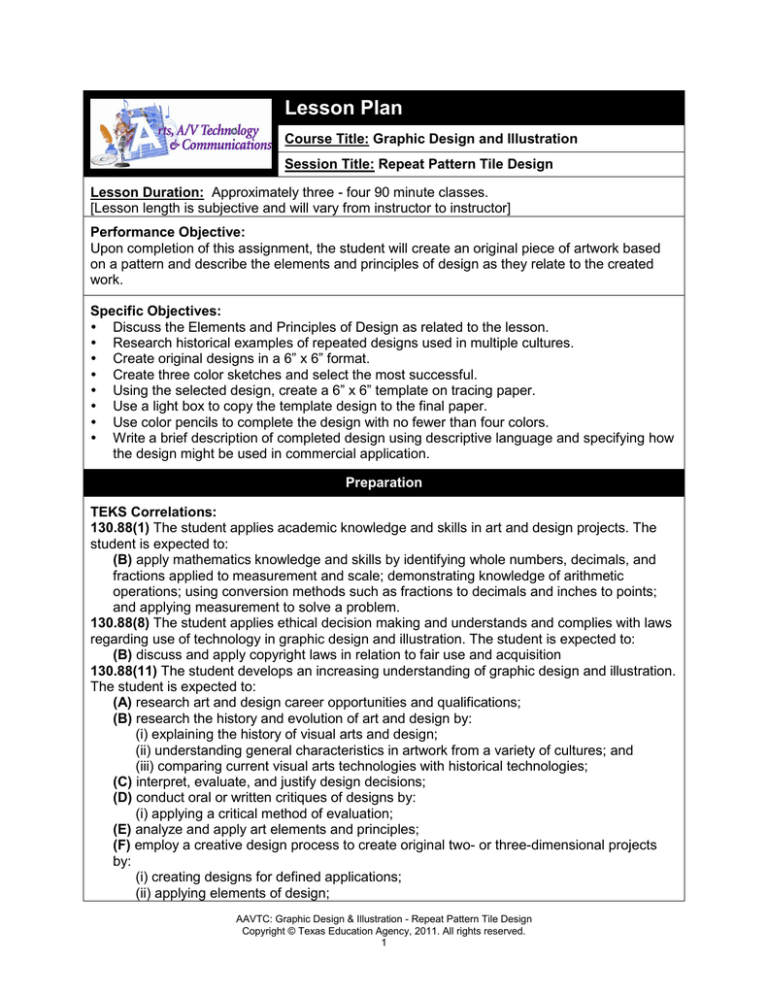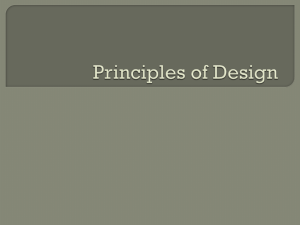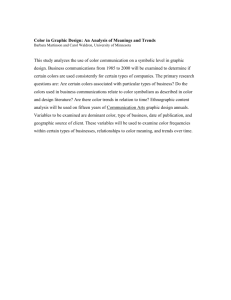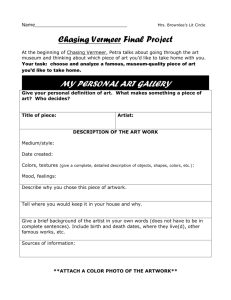Lesson Plan
advertisement

Lesson Plan Course Title: Graphic Design and Illustration Session Title: Repeat Pattern Tile Design Lesson Duration: Approximately three - four 90 minute classes. [Lesson length is subjective and will vary from instructor to instructor] Performance Objective: Upon completion of this assignment, the student will create an original piece of artwork based on a pattern and describe the elements and principles of design as they relate to the created work. Specific Objectives: Discuss the Elements and Principles of Design as related to the lesson. Research historical examples of repeated designs used in multiple cultures. Create original designs in a 6” x 6” format. Create three color sketches and select the most successful. Using the selected design, create a 6” x 6” template on tracing paper. Use a light box to copy the template design to the final paper. Use color pencils to complete the design with no fewer than four colors. Write a brief description of completed design using descriptive language and specifying how the design might be used in commercial application. Preparation TEKS Correlations: 130.88(1) The student applies academic knowledge and skills in art and design projects. The student is expected to: (B) apply mathematics knowledge and skills by identifying whole numbers, decimals, and fractions applied to measurement and scale; demonstrating knowledge of arithmetic operations; using conversion methods such as fractions to decimals and inches to points; and applying measurement to solve a problem. 130.88(8) The student applies ethical decision making and understands and complies with laws regarding use of technology in graphic design and illustration. The student is expected to: (B) discuss and apply copyright laws in relation to fair use and acquisition 130.88(11) The student develops an increasing understanding of graphic design and illustration. The student is expected to: (A) research art and design career opportunities and qualifications; (B) research the history and evolution of art and design by: (i) explaining the history of visual arts and design; (ii) understanding general characteristics in artwork from a variety of cultures; and (iii) comparing current visual arts technologies with historical technologies; (C) interpret, evaluate, and justify design decisions; (D) conduct oral or written critiques of designs by: (i) applying a critical method of evaluation; (E) analyze and apply art elements and principles; (F) employ a creative design process to create original two- or three-dimensional projects by: (i) creating designs for defined applications; (ii) applying elements of design; AAVTC: Graphic Design & Illustration - Repeat Pattern Tile Design Copyright © Texas Education Agency, 2011. All rights reserved. 1 (iv) using good composition; (vii) creating a project by applying color Interdisciplinary Correlations Art, Level I: 117.52 (c)(1) Perception. The student develops and organizes ideas from the environment. The student is expected to: (A) illustrate ideas for artworks from direct observation, experiences, and imagination; and (B) compare and contrast the use of art elements (color, texture, form, line, space, value) and art principles (emphasis, pattern, rhythm, balance, proportion, unity) in personal artworks and those of others, using vocabulary accurately. 117.52 (c)(2) Creative expression/performance. The student expresses ideas through original artworks, using a variety of media with appropriate skill. The student is expected to: (A) create visual solutions by elaborating on direct observation, experiences, and imagination; (C) demonstrate effective use of art media and tools in design, drawing, painting, printmaking, and sculpture. 117.52 (c)(3) Historical/cultural heritage. The student demonstrates an understanding of art history and culture as records of human achievement. The student is expected to: (A) compare and contrast historical and contemporary styles, identifying general themes and trends; (B) describe general characteristics in artworks from a variety of cultures; and (C) compare and contrast career and avocational opportunities in art. Instructor/Trainer References: 1. Research online references for Elements and Principles of Design 2. Research online for the Victoria and Albert Museum 3. National Museum of the American Indian, http://www.nmai.si.edu/ 4. Textile pattern online references: http://www.metmuseum.org/toah/hd/geom/hd_geom.htm, http://www.textilemuseum.org/exhibitions/previous.htm, http://www.medievaltextiles.org/gallery/gallery.html, www.dartmouth.edu 5. Research online references for Color Harmonies Instructional Aids: 1. Slide presentation with examples of repeat tile designs and other designs from multiple cultural sources. 2. Handout from the J. Paul Getty Museum, Elements of Art: http://www.getty.edu/education/teachers/building_lessons/elements_art.pdf 3. Handout on the Principles of Design Materials Needed: 1. Tracing paper 2. Black markers 3. Rulers, pencils 4. 14” x 14” square drawing paper 5. Copy paper cut into 6” squares 6. Color pencils 7. Color Wheel AAVTC: Graphic Design & Illustration - Repeat Pattern Tile Design Copyright © Texas Education Agency, 2011. All rights reserved. 2 Equipment Needed: 1. Projector for Slide Presentation 2. Computer with online access 3. Light box for tracing. Learner Online searches for design inspiration using the Victoria and Albert Museum, and the National Museum of the American Indian, http://www.nmai.si.edu/ as a starting point. Introduction MI Introduction (LSI Quadrant I): SHOW: Slide Presentation on Repeat Design. SAY: Cultures throughout history have used repeated designs to embellish functional and decorative objects such as tiles, ceramics, metalwork, jewelry, fabrics, weaving, and beadwork. ASK: What other designs can you think of with cultural references – such as tattoos? SAY: Design is also an integral part of certain religious relics and ceremonies such as sand mandalas created by Tibetan Buddhist monks or labyrinths and stained glass in Christian cathedrals. SAY: Periods and Styles (such as Art Deco, Art and Crafts, Rococo, Medieval, Meiji, and countless others) have distinctive qualities. ASK: Do you identify with a particular cultural reference, or have a favorite art period or style? How does that influence your design choices? SAY: Look around and take note of the use of repeated designs that you see daily. Tee shirts, mugs, and corporate logos utilize repetitive designs. Though the manufacturing methods have changed from centuries past; we still make use of repetitive designs in much the same way as people always have. ASK: Are there distinctive qualities to contemporary repeated designs and do they reflect the cultures in which they are created? ASK: In what type of industries might a designer or illustrator be employed? Outline MI Outline (LSI Quadrant II): Instructor Notes: I. Special emphasis on Pattern, Balance, Unity, and Color Harmony. II. Elements and Principles of Design A. Unity B. Variety C. Emphasis D. Balance E. Proportion F. Pattern G. Rhythm H. Line I. Shape J. Form K. Space L. Color M. Texture Repeated Designs A. Multiple cultures Handouts The Victoria and Albert Museum online site has AAVTC: Graphic Design & Illustration - Repeat Pattern Tile Design Copyright © Texas Education Agency, 2011. All rights reserved. 3 B. Artistic Movements some of the best examples of decorative design across cultures throughout history. The National Museum of the American Indian is another excellent resource. Challenge students to find other internet sources. III. Create Original Sketches A. Designs on a 6” square format. B. Fold the square in half so that it forms a triangle. C. Design at edges must meet at the same point on the opposite half. D. Work out a harmonious color scheme with no fewer than four colors. Stress that sketches should be original. They may use the examples shown as inspiration but should make the designs uniquely their own. If necessary, re-teach color theory and emotional associations of color. Discuss analogous, complementary, and combinations on the color wheel. IV. Color sketches will be shown to the client for selection and approval A. Instructor will act at the client B. Three Color sketches are to be completed C. Select most successful sketch for the 6” square The instructor will act as the client. Assist the student in selecting the most appropriate design. V. Create a 6” square template A. Use black fine tip markers and tracing paper. B. Proper measurements required A. Check measurements with client before proceeding VI. Preparing Final Paper A. Use 14” x 14” sheet of white paper B. Measure and mark the top and bottom of each edge at 1”, 7”, and 13”. C. Lightly draw a line so that there is a 1” border and the page is divided into four equal parts. VII. Creating Final Design A. Use a Light Box to copy template design onto final paper. B. Position template under final paper aligning to one of the four quadrants Proper measurements are critical and should be checked. A sunny window may be used instead of a light box. Alternately, a “carbon” may be made by using a soft pencil on the back side of the AAVTC: Graphic Design & Illustration - Repeat Pattern Tile Design Copyright © Texas Education Agency, 2011. All rights reserved. 4 IX. C. Center point always remains steady D. Trace design and rotate template 90 degrees E. Trace the new quadrant and repeat until transfer is complete template and tracing over the line design. Complete Design A. No fewer than four colors using pencils or markers B. Must be consistent in color and technique throughout each of the quadrants C. Final product forms a unified whole. May need to re-teach color pencil technique including visual texture and tints. X. Final Process A. Write a brief description of completed design B. Use descriptive language C. Specify how the design could be used in commercial application D. Complete self assessment portion of rubric Application MI Guided Practice (LSI Quadrant III): The teacher will demonstrate how the patterns align, are rotated and repeated by using a sample template while students observe. The teacher will post a visual representation on a white/black board with the measurement specifics for the final artwork. MI Independent Practice (LSI Quadrant III): Students will conduct research, develop ideas and create artworks independently. Summary MI Review (LSI Quadrants I and IV): Q & A Session: Q: How have people throughout history made use of design in their everyday lives? A: To embellish textiles, tiles, jewelry, ironwork, ceramics, beadwork, etc. Q: How is design/illustration used in products and product marketing today? A: Still used to decorate consumer products. Other uses include logo design, AAVTC: Graphic Design & Illustration - Repeat Pattern Tile Design Copyright © Texas Education Agency, 2011. All rights reserved. 5 signage, and graphics. Q: What is Balance in an artwork? A: The way in which an artwork is arranged to make the different parts seem equally important. Q: Describe the different types of balance used in this project. A: Symmetrical Balance – both sides of a center line are the same, or about the same. Example: butterfly wings, our bodies. Radial Balance – a type of balance in which shapes or lines spread out from a center point, like a wheel. Q: Describe an analogous color scheme. A: Colors next to each other on the color wheel such as yellow, yellow green, green, blue green, blue. Q: What are complementary colors and describe their effect when used together in a color scheme. A: Colors opposite each other on the color wheel like red and green. The high contrast of complementary colors creates a vibrant look especially when used at full saturation. This color scheme must be managed well so it is not jarring. Complementary colors are tricky to use in large doses, but work well when you want something to stand out. Complementary colors are really bad for text. Q: When talking about color, what is a “tint” and describe how to achieve tints using color pencil technique? A: A tint is the addition of white (when using paint) to a color. When using color pencil technique, a tint can be achieved by using a light, steady application of color rather than bearing down with the pencil. Q: Describe the difference between “geometric” and “organic” lines or shapes. A: Geometric shapes have sharp edges and create precise patterns. Organic shapes are curved and have natural, irregular edges. Q: Why are precise measurements critical to the success of this project? A: If the measurements are “off”, the repeated pattern will not match up and flow throughout creating disunity. Evaluation MI Informal Assessment (LSI Quadrant III): Teacher will circulate during independent practice checking for understanding of concepts and techniques. Teacher will observe student progress and make suggestions / provide guidance as necessary. MI Formal Assessment (LSI Quadrant III, IV): Rubric for Repeat Tile Design Extension MI Extension/Enrichment (LSI Quadrant IV): Create a three-dimensional bas relief tile using the same design in clay. Use linoleum block printing to recreate the lesson. AAVTC: Graphic Design & Illustration - Repeat Pattern Tile Design Copyright © Texas Education Agency, 2011. All rights reserved. 6 Principles of Design Handout Unity – a quality that occurs when all part of an artwork combine to create a sense of completion and wholeness. Variety – a combination of the elements of art to provide interest in the artwork Emphasis – the visual sense of importance given to objects or areas in artwork. This is accomplished with the size, color, shape, or placement of an object or area to create dominance, contrast, or a focal point. Balance – the ways an artwork is arranged to make the different parts seem equally important. Symmetrical Balance – (formal balance) type of balance where both sides of a center line are the same, or about the same. Example: our faces, our bodies. Asymmetrical Balance – (informal balance) type of balance where two sides of an artwork are not alike, but carry equal or nearly equal visual weight. Both sides look equally important but they are not the same. Radial Balance – a type of balance in which shapes or lines spread out from a center point, like a wheel. Proportion – the size relationship of the parts of an artwork to each other and/or to the whole piece. Example: the size relationship of the nose to the whole face shows proportion. Pattern – repetition of line, shape, color, texture, space or form in an artwork. A pattern is a model or plan to be followed when making something. Rhythm – a sense of visual movement or motion caused by the repetition of the elements of art in an artwork. In music, rhythm refers to the pattern of the notes. Progressive Rhythm – Rhythm created by showing regular changes in a repeated element, such as a series of squares that progressively increase in size from small to large. The changes may also progress from top to bottom, or dark to light. Regular Rhythm – Rhythm in an artwork created by repeating the same element, such as a shape, without variation. Alternating Rhythm – Rhythm created by repeating two or more elements on a regular, interchanging basis. AAVTC: Graphic Design & Illustration - Repeat Pattern Tile Design Copyright © Texas Education Agency, 2011. All rights reserved. 7 Repeat Pattern Tile Design Rubric Student Name: Evaluation Criteria Excellent (12.5 pts.) Good (10 pts.) Poor (7 pt.) Contributes to the discussion, adds new points of consideration. Some participation in discussion. Not engaged in discussion. Produces one fully formed design sketch with good radial balance, consistent line and shape, focus and unity. Weak sketches with limited execution of good design principles. Good color usage that enhances the design concept and uses at least four colors. Limited color exploration. Color theme detracts from the overall design. Does not use at least four colors. Unique design Good understanding of historical perspective. Adapts and updates examples. Borrows heavily or copies examples directly. Template design is executed properly. Final measurements are correct and repeated pattern aligns properly in each quarter. Template is well executed. Overall appearance of final product is good. Neatness Excellent execution, clean with consistent color and technique. Clean with consistent color and technique. Completion All steps of the project are completed on time and correctly. All steps of the project are completed on time with corrections made in timely manner. Fails to observe the steps and deadlines. Well written personal statement using appropriate vocabulary. Description of how the artwork could be used in practical application. Good statement using appropriate vocabulary. Description of how the artwork could be used in practical application. Limited statement. Classroom Participation. Observation and understanding of historical design uses and examples. Design sketches Color Scheme Originality of design Correct measurements and alignment Self Assessment Produces three viable design sketches that demonstrate good radial balance, consistent line and shape, focus and unity. Demonstrates understanding of color theory. Good color exploration with use of tints. Uses at least four colors. Color enhances the design concept. Repeated pattern does not align or is not rotated correctly. Measurements are off-center. Messy, smudged, or folded, colors not consistent in final product. Total Score Max = 100 AAVTC: Graphic Design & Illustration - Repeat Pattern Tile Design Copyright © Texas Education Agency, 2011. All rights reserved. 8 Score





